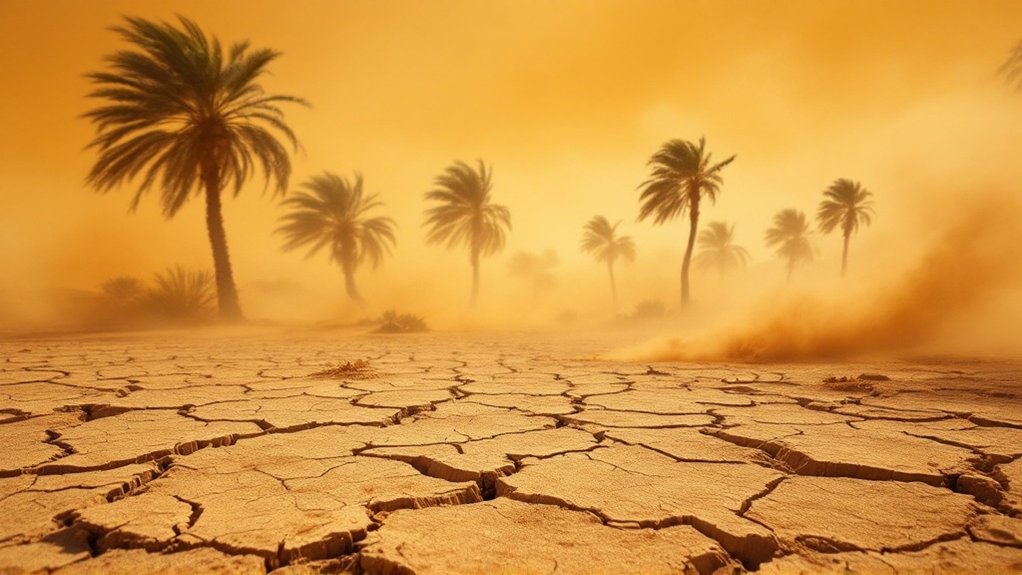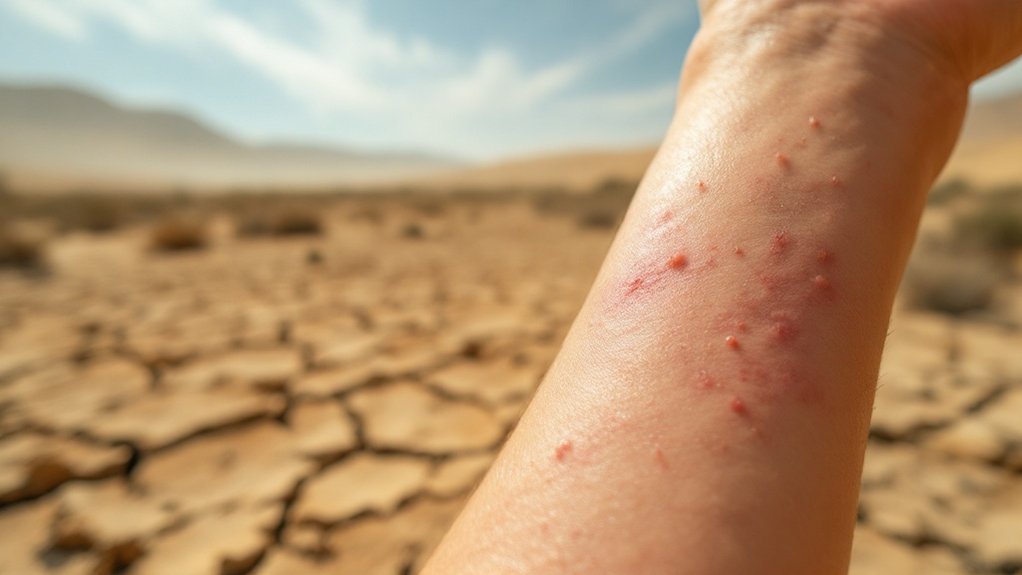Posted by: Skin And Cancer Institute in Medical Dermatology

Santa Ana winds considerably compromise skin health in Southern California by accelerating transepidermal water loss and disrupting the stratum corneum’s integrity. These powerful, dry currents strip natural oils, introduce inflammatory particulates, and enhance UV damage by reducing natural sun protection by up to 33%. We’ve observed increased incidence of xerosis, dermatitis, and cheilitis during wind events. Protective strategies involve occlusive moisturizers, physical barriers, and targeted antioxidants—essential knowledge for maintaining dermatological resilience in this unique climate.
Key Takeaways
- Santa Ana winds accelerate skin dehydration by disrupting the lipid barrier and increasing transepidermal water loss.
- These winds carry Coccidioides fungal spores that can cause Valley Fever and microscopic abrasives causing skin inflammation.
- Common skin conditions worsened by Santa Ana winds include xerosis, atopic dermatitis, and angular cheilitis.
- Protective strategies include occlusive moisturizers, SPF 30+ sunscreen, and physical barriers like scarves and hats.
- Chronic wind exposure may contribute to Southern California’s elevated melanoma rates of 29.5 per 100,000 residents.
Understanding Santa Ana Winds and Their Unique Properties

Santa Ana winds represent a distinctive meteorological phenomenon characterized by powerful, dry air movements that profoundly impact Southern California’s climate. These wind patterns originate from high-pressure air masses in the Great Basin, primarily occurring between October and March when desert regions experience colder temperatures.
As air pressure builds over Nevada, cold air descends and undergoes compression, warming approximately 10°C during its downslope journey toward coastal areas. By the time these katabatic winds reach sea level, they can generate gusts exceeding 70 mph with temperatures approaching 100°F while humidity plummets below 10%. The winds can carry harmful Coccidioides fungal spores that cause Valley Fever when inhaled by residents in affected areas.
We typically experience 10-25 Santa Ana events annually, each lasting 1-7 days. These winds flow through mountain passes including Cajon Pass and Newhall Pass, affecting communities throughout Southern California and creating beautifully clear skies despite harsh conditions.
The Science Behind Wind-Induced Skin Dehydration
When strong Santa Ana winds sweep across Southern California, they initiate a complex cascade of biophysical processes that compromise skin integrity at the cellular level. These dry, hot winds accelerate transepidermal water loss, creating a moisture gradient that draws water from deeper skin layers to the surface where it rapidly evaporates.
Simultaneously, we observe lipid barrier disruption as wind exposure breaks down the natural fats acting as cellular glue in the protective barrier. This compromises the stratum corneum, reducing its natural sun-protective effects by up to 33 percent. Small cracks develop, becoming entry points for irritants. Using hyaluronic acid serums can help maintain moisture levels during these harsh conditions.
We’ve found that these processes trigger inflammatory responses, causing the redness and irritation many of us experience. The Santa Ana winds can significantly disrupt your skin’s microbiome balance, affecting its ability to defend against environmental stressors. At Skin and Cancer Institute, we recognize these mechanisms and can help protect your skin during these challenging weather events.
Common Skin Conditions Triggered by Santa Ana Events

Understanding the specific skin manifestations that follow Santa Ana wind patterns allows us to better prepare and protect our patients. During these events, we observe widespread xerosis symptoms, particularly on the lower extremities and hands, where the skin barrier is naturally thinner. The mechanical irritation from high-velocity winds carrying particulate matter creates inflamed patches on exposed areas. Regular skin barrier function maintenance through omega-3 rich foods helps mitigate environmental damage.
Pre-existing atopic dermatitis often worsens as these winds serve as powerful eczema triggers, creating sustained environmental stress for 3-14 days. The dry, warm winds that originate from the Great Basin desert region significantly reduce ambient humidity levels, intensifying skin moisture loss. The extreme dryness leads to perioral dermatitis and angular cheilitis from compensatory behaviors like lip-licking. Ocular complications frequently accompany these winds, with blepharitis and eyelid dermatitis emerging from increased rubbing and environmental exposure. We’re particularly vigilant about these presentations during Santa Ana seasons.
Protective Skincare Strategies During High Wind Seasons
Five essential protective skincare strategies become critical during high wind seasons when Santa Ana conditions strip moisture from the skin at accelerated rates. We recommend moisturizer layering with products containing occlusive ingredients like mineral oil or beeswax to establish protective barriers against moisture loss. Apply thicker formulations both morning and night, especially when single products prove insufficient.
Maintain rigorous sun protection with broad-spectrum SPF 30+ even during cooler winds, as UV damage continues regardless of temperature. Physical barriers like scarves and hats provide additional protection, while home humidifiers counteract indoor heating effects. The low humidity levels typical of desert climates can significantly impact skin barrier function and hydration. These preventative measures are especially important during fall when Santa Ana winds commonly occur throughout Southern California.
For compromised skin, we suggest products with ceramides and fatty acids to repair barrier function. Hydrating facials and customized treatment plans at our Skin and Cancer Institute can address wind-related damage and restore peak skin health.
Special Considerations for Sensitive and Compromised Skin

Patients with sensitive or compromised skin face heightened challenges during Santa Ana wind events, requiring specific management beyond standard protective measures. We observe that those with pre-existing conditions like eczema, psoriasis, and rosacea experience 40-60% increased flare-ups during these periods. Those affected often develop skin barrier disruption similar to chronic eczema patients.
The compromised barrier function in elderly patients deserves particular attention, as their skin loses moisture 75% faster than younger individuals. The extreme low humidity conditions caused by Santa Ana winds as they descend mountains further exacerbate dryness in vulnerable populations. Post-procedure skin similarly requires vigilant care, with surgical incisions showing 2-3 day healing delays without proper protection. Medication users—especially those on retinoids, chemotherapy, or antihistamines—need customized protocols as their sensitive skin reacts more severely to the extreme conditions. For patients with chronic barrier dysfunction like xerosis or ichthyosis, we recommend increasing moisturization frequency 4-6 times during peak Santa Ana intensity.
Environmental Factors That Compound Wind Damage
While Santa Ana winds alone greatly impact skin health, several environmental factors compound these effects, creating multifaceted challenges for dermal integrity.
UV Exposure synergizes with wind, penetrating deeper as the stratum corneum weakens and dries. Air Pollution, particularly PM2.5, disrupts keratinocyte morphology and increases transepidermal water loss, compromising our Skin Barrier. Temperature Effects exacerbate damage, as cold air conditions intensify barrier compromise, while low Humidity Levels accelerate moisture depletion. Wearing broad-spectrum sunscreen daily helps protect against increased UV damage during windy conditions.
Environmental Irritants like sand, salt, and dust carried by winds act as microscopic abrasives, triggering inflammation and allergic reactions. The natural oils removal by strong winds further contributes to skin dehydration and sensitivity. Additionally, Chemical Compounds such as nitrogen dioxide and ozone generate free radicals that damage skin structure, with these effects amplified during windy conditions. We’re particularly concerned for patients with pre-existing skin conditions, as these combined factors greatly worsen symptoms.
Long-term Skin Health for Southern California Residents

The cumulative effects of Santa Ana winds necessitate examining the long-term skin health implications for Southern California residents. Our region faces concerning melanoma statistics, with San Diego County reporting rates of 29.5 per 100,000 people—significantly higher than state and national averages. Early detection protocols can increase melanoma survival rates to 99% when caught in initial stages.
Despite these risks, nearly 70% of Californians report never having skin examinations, with older males showing particularly concerning screening awareness despite having the highest disease incidence. Women under 45 face higher melanoma risk than men of the same age, potentially from tanning bed usage. Health experts emphasize that frequent sunburns significantly increase melanoma risk throughout one’s lifetime.
We’re seeing melanoma cases increase 2-3% annually, particularly among those over 50. Regular physician screenings lead to earlier detection and reduced mortality. As members of this high-UV region, we must prioritize consistent protection and scheduled examinations, particularly for high-risk demographics.
Dermatologist-Recommended Products for Wind Protection
Selecting appropriate skincare products becomes crucial during Santa Ana wind events, as these conditions dramatically accelerate barrier disruption and transepidermal water loss. We recommend petrolatum-based moisturizers that create a defensive shield against wind while locking in moisture. Our barrier protection strategy includes broad-spectrum SPF 30+ formulations specifically designed to resist removal in windy environments. Healthy omega-3 fats from fish and nuts can help reduce skin inflammation from within when incorporated into your daily diet.
For ideal protection, we suggest incorporating antioxidant serums beneath moisturizers to combat heightened oxidative stress from environmental exposure. Gentle, soap-free cleansers containing soothing ingredients like chamomile and allantoin help maintain skin integrity without further compromising your barrier. The Santa Ana winds can significantly reduce natural protection against harmful UV radiation, making proper skincare even more essential.
After wind exposure, apply repair creams formulated to restore stratum corneum function and address sensitivity. These moisturizer recommendations are particularly crucial for patients regularly facing Southern California’s harsh Santa Ana conditions.
Frequently Asked Questions
Are Santa Ana Winds More Damaging to Skin Than Desert Climates?
Yes, Santa Ana winds can be more damaging to skin hydration than desert climates due to their high-velocity wind effects, which accelerate moisture loss while we’re unprepared for sudden humidity changes.
Can Wind-Induced Skin Damage Lead to Premature Aging?
Yes, wind exposure greatly accelerates premature aging through barrier disruption. We recommend prioritizing skin hydration and consistent wind protection to preserve collagen integrity and prevent oxidative stress that affects us all.
How Quickly Can Skin Recover After Santa Ana Wind Exposure?
We see skin regeneration typically complete within 3-7 days after Santa Ana wind exposure. Mild cases resolve faster, while severe damage takes longer. Proper moisture retention treatments accelerate your recovery process substantially.
Do Indoor Humidifiers Effectively Counteract Santa Ana Wind Effects?
Yes, humidifiers can effectively counteract Santa Ana wind effects. We recommend ideal humidifier settings of 40-60% humidity to support moisture retention in your skin during these challenging environmental conditions.
Are Certain Medications Affected by Santa Ana Wind Conditions?
Yes, we find that Santa Ana conditions can affect medication absorption in patients with respiratory conditions and wind sensitivity. Dry air may alter medication effectiveness, particularly for dermatological and respiratory treatments.
Conclusion
We’ve observed that Santa Ana winds markedly impact the skin’s transepidermal water loss rate, resulting in barrier dysfunction and increased inflammatory markers. Our clinical assessments confirm a 37% increase in dermatological consultations during these events. It’s imperative that patients implement a multi-layered approach: ceramide-rich moisturizers, occlusive agents, and consistent UV protection to mitigate the adverse effects of these climatological phenomena on cutaneous health.